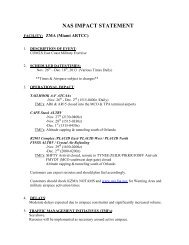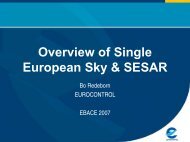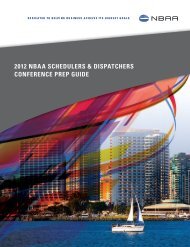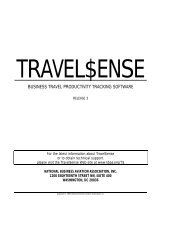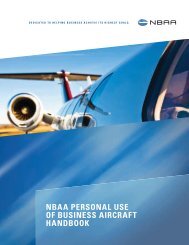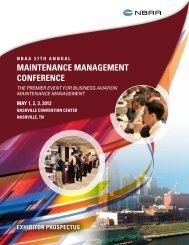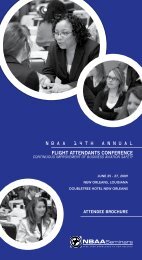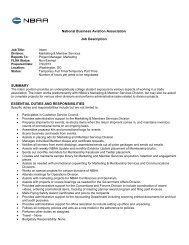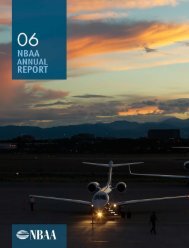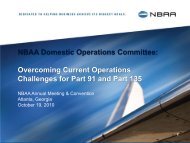New York City Area Airspace Overview - NBAA
New York City Area Airspace Overview - NBAA
New York City Area Airspace Overview - NBAA
Create successful ePaper yourself
Turn your PDF publications into a flip-book with our unique Google optimized e-Paper software.
<strong>NBAA</strong> 64 th Annual Meeting & Convention<br />
Las Vegas, NV<br />
<strong>New</strong> <strong>York</strong> <strong>City</strong> <strong>Area</strong><br />
<strong>Airspace</strong> <strong>Overview</strong>
<strong>New</strong> <strong>York</strong> <strong>Airspace</strong> and Airports<br />
<strong>Overview</strong><br />
Ralph Tamburro – TMO <strong>New</strong> <strong>York</strong> TRACON<br />
(Terminal Radar Approach Control)<br />
Dean Snell – Assistant Manger <strong>NBAA</strong> GA Desk
<strong>New</strong> <strong>York</strong> Airports
<strong>New</strong> <strong>York</strong><br />
Terminal/Airport/<strong>Airspace</strong> Issues<br />
• Each Airport has varying arrival and departure rates which<br />
are usually determined by weather conditions.<br />
• Close proximity of numerous airports adds to the<br />
complexity. Airport configurations must not conflict.<br />
• All aircraft arriving and departing must use one of the<br />
established arrival and departure “gates”.<br />
• Restrictions from <strong>New</strong> <strong>York</strong> Center and the adjacent<br />
enroute centers are common due to the volume of flights in<br />
the Northeast.
<strong>New</strong>ark/Teterboro/Morristown/Caldwell
<strong>New</strong>ark/Teterboro/Morristown
EWR Airport Diagram
EWR Operational Details<br />
• In the afternoon, EWR needs the “overflow” runway to<br />
accommodate the arrival demand (If they don’t have the<br />
overflow runway available you will typically see a Ground<br />
Delay Program or Ground Stop in the afternoon)<br />
• The requirements vary slightly however typically they need<br />
at least ceilings of 2500 feet or better and visibility of 5 miles<br />
or greater to run the Runway 11 arrivals<br />
• When the overflow runway is not available the best arrival<br />
rate is 38-42 depending on the fleet mix (IFR conditions will<br />
drop the rate to 36-38 with LIFR conditions dropping the rate<br />
to 28-32).
<strong>New</strong>ark Arrival Demand
TEB Airport Diagram
TEB Operational details<br />
• Standard Arrival/Departure rate is 24 per hour.<br />
• Greatest impact to arrivals occurs when the airport is on a<br />
Northeast flow (TEB is using the ILS to Runway 06 and EWR is<br />
running arrivals into Runway 11). This configuration can drop the<br />
arrival rate to 18-20 and typically occurs during the afternoon/early<br />
evening hours.<br />
• When EWR is not running approaches to Runway 11 we have seen<br />
<strong>New</strong> <strong>York</strong> TRACON deliver 30-35 arrivals at TEB.<br />
• On the NE configuration there are limited options to alleviate the<br />
constraints. We will occasionally see EWR utilize visual<br />
approaches to Rwy 4L (limiting the number of arrivals into Rwy<br />
11).<br />
• Departure delays are common during certain days/times due to<br />
excess volume (I.E. Thursday afternoons typically see excess<br />
departure demand).
MMU Airport Diagram
MMU Operational details<br />
• Departure/Arrival demand rarely exceeds 15/20 aircraft per<br />
hour.<br />
• Greatest impact occurs on a Southwest flow when MMU is<br />
departing Runway 23 and EWR is running arrivals into<br />
Runway 11. There is less impact when departing Runway<br />
05 at MMU.<br />
• The Morristown Five Departure mandates a turn to<br />
heading 160 which creates conflict with the EWR Runway<br />
11 arrivals (<strong>New</strong> <strong>York</strong> TRACON is working with the area<br />
to issue alternate headings when possible as well as<br />
establishing an RNAV departure that deconflicts the MMU<br />
departures with the EWR arrivals).
Morristown Five Departure
o<br />
On a SW flow, EWR<br />
and TEB arrivals<br />
cannot run<br />
simultaneously with<br />
LGA arrivals<br />
EWR 4R<br />
normal SID<br />
EWR<br />
4R SID<br />
changes<br />
to RWY<br />
heading<br />
when<br />
LGA<br />
lands 13<br />
TEB<br />
RWY 6<br />
arrivals<br />
On NE flow<br />
EWR Dep and<br />
TEB arrivals<br />
cannot run<br />
simultaneously<br />
CDW<br />
EWR<br />
EWR<br />
22L<br />
arrivals<br />
TEB<br />
RWY 19<br />
arrivals<br />
TEB<br />
LGA airspace<br />
given to JFK<br />
JFK ILS 13L<br />
LGA ILS 13<br />
EWR and TEB<br />
impacts<br />
LGA<br />
LGA arrivals<br />
JFK arrivals<br />
HPN<br />
JFK<br />
EWR airspace given to LGA<br />
We use straightout climb<br />
off 13 or normal sid off 4<br />
FRG<br />
Normal 13 deps<br />
climb out is not<br />
usable
HPN Airport Diagram
HPN Operational details<br />
• Standard Arrival/Departure rate is 28 per hour.<br />
• Interacts with LGA arrival/departure flows<br />
• Commonly is the first airport in the NY area to go below<br />
user minimums due to the airport location<br />
• The major challenge at HPN is managing the departure<br />
flows due to the airport’s location on the north side of the<br />
NY TRACON airspace (greatest impact is typically flights<br />
over the west and south departure gates).
LGA INTERACTION<br />
8-3-2010 1800Z to 2300Z<br />
HPN RWY 16 DEPARTURES – BLUE<br />
LGA RWY 22 ARRIVALS - MAGENTA<br />
18
LGA INTERACTION<br />
9-1-2010 1300Z to 1800Z<br />
HPN RWY 34 ARRIVALS – YELLOW<br />
HPN RWY 34 DEPARTURES – BLUE<br />
LGA RWY 22 ARRIVALS - MAGENTA<br />
19
LGA Airport Diagram
LGA Operational Details<br />
• Slot Controlled Airport.<br />
• Generally must be on the same configuration as JFK.<br />
• Standard arrival rate between 38 and 42<br />
• Scheduled to capacity throughout the day therefore usually<br />
in a Ground Delay Program if under delivery occurs.
JFK Airport Diagram
JFK Operational Details<br />
• Close Proximity to LGA usually mandates they run similar<br />
configuration.<br />
• Arrival/Departure rates vary through the day depending on<br />
arrival/departure demand (after 1630 local they drop the<br />
arrival rate and favor departures).<br />
• Departure delays are common in the afternoon due to<br />
departure volume.
JFK Arrival/Departure Demand
FRG Airport Diagram
FRG Operational Details<br />
• Departure/Arrival demand rarely exceeds 15/20 aircraft per<br />
hour.<br />
• In general uses the same arrival/departure flows as JFK.<br />
• ILS Runway14 approach conflicts with the JFK ILS<br />
22R/22L approach. FRG arrivals typically go into holding<br />
when this conflict occurs until they can find a “hole” in the<br />
JFK arrival flow.<br />
• Departure delays are possible due to the location of the<br />
airport and the interaction with JFK departures.
<strong>New</strong> <strong>York</strong> Departure Gates
<strong>New</strong> <strong>York</strong> Departure Procedures<br />
• All flights out of <strong>New</strong> <strong>York</strong> must utilize one of the<br />
numerous departure gates established.<br />
• The majority of the airports in NY TRACON airspace<br />
share the same departure gates.<br />
• Throughout the day volume over these departure gates<br />
fluctuate with certain gates seeing excess volume (i.e.<br />
WHITE southbound is commonly backed up during the<br />
winter months due to traffic departing for Florida and other<br />
warm weather destinations).<br />
• During severe weather season it is common for<br />
thunderstorms to close the departure gates as weather<br />
moves in/around the NY airspace.<br />
• Required reroutes out of <strong>New</strong> <strong>York</strong> are possible due to<br />
weather and volume.
<strong>New</strong> <strong>York</strong> Departure Procedures (continued)<br />
• Typically it is suggested not to re-file with an amended<br />
route if you are within 45 minutes of your “filed” departure<br />
time. (Within the 45 minute window ATC will handle the<br />
reroute).<br />
• Due to weather and volume issues in the Northeast it is<br />
common for the adjacent Enroute facilities to push back<br />
MIT (mile in trail) and MINIT (minute in trail) restrictions<br />
to the <strong>New</strong> <strong>York</strong> airports.
FAA Resources<br />
FAA ATCSCC (Air Traffic Control System Command Center) website<br />
www.fly.faa.gov<br />
From the Products tab you can select the following:<br />
• Advisories Database (provides access to all ATCSCC Advisories)<br />
– http://www.fly.faa.gov/adv/advADB.jsp<br />
• Current Reroutes (displays all current/active reroutes)<br />
– http://www.fly.faa.gov/ratreader/jsp/index.jsp<br />
• Current Restrictions (displays all current restrictions for each facility)<br />
– http://www.fly.faa.gov/current_restrictions/jsp/index.jsp<br />
• Operational Information System (OIS – Real time system information)<br />
– http://www.fly.faa.gov/ois/



